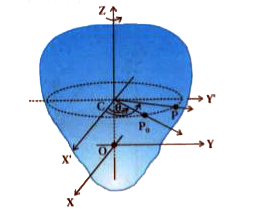What is the value of tangential component of a linear acceleration for a representation particle moving in uniform angular motion rotational motion? Solution in Gujrati
The tangential component of a linear acceleration for a particle moving with constant angular velocity in rotational motion is here
Topper's Solved these Questions
- SYSTEMS OF PARTICLES AND ROTATIONAL MOTIONBook:KUMAR PRAKASHANChapter:SYSTEMS OF PARTICLES AND ROTATIONAL MOTIONExercise:SECTION-D NCERT EXEMPLAR SOLUTIONS
Explore 13 Videos
- SYSTEMS OF PARTICLES AND ROTATIONAL MOTIONBook:KUMAR PRAKASHANChapter:SYSTEMS OF PARTICLES AND ROTATIONAL MOTIONExercise:SECTION-D NCERT EXEMPLAR SOLUTIONS (VERY SHORT ANSWER TYPE QUESTIONS)
Explore 5 Videos
- SYSTEMS OF PARTICLES AND ROTATIONAL MOTIONBook:KUMAR PRAKASHANChapter:SYSTEMS OF PARTICLES AND ROTATIONAL MOTIONExercise:SECTION-B NUMERICAL FROM .DARPAN. BASED ON TEXTBOOK
Explore 17 Videos
- QUESTIONS ASKED IN JEE - 2020 Book:KUMAR PRAKASHANChapter:QUESTIONS ASKED IN JEE - 2020 Exercise:Question
Explore 16 Videos
- THERMAL PROPERTIES OF MATTERBook:KUMAR PRAKASHANChapter:THERMAL PROPERTIES OF MATTERExercise:Question Paper (Section - D) (Answer following in brief :) Each carry 4 marks
Explore 1 Video
Similar Questions
For which of the following does the centre of mass lie outside the body?
View SolutionThe centre of gravity of a body on the earth coincides with its centre of mass for a small object whereas for an extended object it may not. What is the qualitative meaning of small and extended in this regard? For which of the following two coincides? A building, a pond, a lake, a mountain?
View SolutionThe particles of mass m1,m2andm3 are placed on the vertices of an equilateral triangle of sides .a.. Find the centre of mass of this system with respect to the position of particle of mass m1.

View SolutionA non-isotropic solid metal cube has coefficient of linear expansion as 5×10−5/∘C along the x-axis and 5×10−6/∘C along y-axis and z-axis. If the coefficient of volumetric expansion of the solid is n×10−6/∘C then the value of n is....
View SolutionIn an experiment on the specific heat of a metal, a 0.20 kg block of the metal at 150∘C is dropped in a copper calorimeter (of water equivalent 0.025 kg) containing 150 cm3 of water at 27∘C. The final temperature is 40∘C. Compute the specific heat of the metal. If heat losses to the surroundings are not negligible, is your answer greater or smaller than the actual value for specific heat of the metal ?
View SolutionSay whether there exists tangential acceleration for a particle describing uniform circular motion.
View SolutionAssertion : For uniform circular motion it is necessary the speed of the particle is constant.
Reason : There is no tangential force or tangential acceleration acting on particle in uniform circular motion.
View SolutionIn non-uniform circular motion , particle will have . . . . . And tangential acceleration
View Solutionवृत्तीय गति में किसी कण के रेखिक त्वरण तथा कोणीय त्वरण में संबंध होता है -
View SolutionAngle between linear and angular momentum for particle performing rotational motion is …... .
View SolutionStatements: For uniform circular motion, it is necessary that the speed of the particle should be uniform. Reason: In a uniform circular motion, there is no tangential acceleration acting on the particle.
View SolutionStatements: For uniform circular motion, it is necessary that the speed of the particle should be uniform. Reason: In a uniform circular motion, there is no tangential acceleration acting on the particle.
View SolutionExplain angular velocity and angular acceleration about fixed axis and derive the equation of rotational motion and write the analogy between the equations of linear motion and rotational motion.

View SolutionWhat is an angle between tangential and radiant components of linear acceleration in circular motion?
View SolutionWhat is the effet of radial and tangential components of linear acceleration in circular motion?
View Solution

